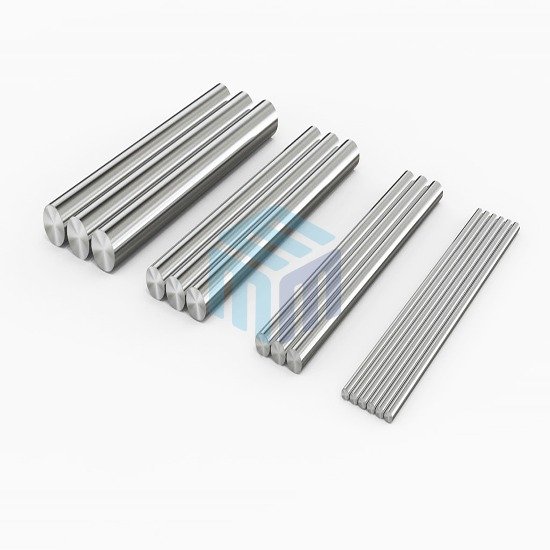Tungsten is one of the most remarkable metals used in modern industry. Known for its exceptional melting point, hardness, and density, tungsten plays a vital role in manufacturing, aerospace, electronics, and energy. But when you start researching tungsten products, you’ll quickly encounter a range of forms: tungsten rods, tungsten tubes, and tungsten bars.
Although these terms are sometimes used interchangeably, each product has unique characteristics, shapes, and applications. Whether you are an engineer, procurement specialist, or simply interested in materials science, understanding the differences between these forms of tungsten can help you choose the right option for your project.
In this article, we’ll break down what sets rods, tubes, and bars apart, how they’re made, and where each is commonly used.
What Are Tungsten Rods?
Tungsten rods are solid cylindrical products with a uniform diameter along their length. They are produced by powder metallurgy processes, where tungsten powder is compacted and sintered, followed by rotary forging or swaging to achieve the final size and density.
Key Characteristics of Tungsten Rods:
- Shape: Solid, round cross-section.
- Sizes: Vary from small diameters (1–2 mm) up to large rods several inches thick.
- Properties: High density, excellent thermal conductivity, and outstanding resistance to corrosion and high temperatures.
- Finishes: Surface can be ground to tight tolerances, polished, or left as-sintered.
Common Applications:
- High-temperature furnace components.
- Radiation shielding.
- Electrodes for welding or electrical discharge machining (EDM).
- Balance weights in aerospace and motorsport.
- Supporting structures in lighting and electronics.
When you purchase tungsten rods from reputable tungsten suppliers, you can specify the grade, purity, and precise dimensions you need.
What Are Tungsten Tubes?
While rods are solid, tungsten tubes are hollow cylindrical components. Essentially, they look like pipes made of dense tungsten metal. Tungsten tubes are typically manufactured using specialized extrusion or deep-hole drilling processes to create the internal cavity.
Key Characteristics of Tungsten Tubes:
- Shape: Hollow cylinder with consistent inner and outer diameters.
- Wall Thickness: Can be thin for thermal applications or thick for structural use.
- Properties: Same high melting point and density as rods, but lighter weight due to the hollow center.
- Sizes: Customizable in length, inner diameter, and outer diameter.
Common Applications:
- Heat shielding in high-vacuum furnaces.
- High-temperature process tubing.
- Medical devices such as radiation therapy collimators.
- Thermocouple protection tubes.
- Specialty aerospace and defense components.
Tungsten tubes offer an excellent combination of reduced weight and thermal performance compared to solid rods. This makes them ideal when space constraints and heat management are critical.
What Are Tungsten Bars?
Tungsten bars are solid rectangular or square cross-section products. Unlike rods, which are always round, bars can be flat or square, and they are often used when machining custom parts that require more material volume in certain directions.
Key Characteristics of Tungsten Bars:
- Shape: Rectangular or square solid profiles.
- Sizes: Produced in various widths, thicknesses, and lengths.
- Properties: Like other tungsten products, they maintain excellent mechanical strength, heat resistance, and density.
- Finishes: Can be ground, machined, or supplied as-sintered.
Common Applications:
- Machined parts for electrical contacts.
- Counterweights in precision equipment.
- Heat sinks in electronic assemblies.
- Die inserts and tooling components.
- Radiation shielding blocks.
When you source tungsten bars, you can select dimensions that allow you to machine the final part while minimizing material waste.
How to Choose Between Tungsten Rods, Tubes, and Bars
Selecting the right tungsten product depends on the specific requirements of your project:
-
Shape and Machinability:
If you need a round, solid component, rods are the best choice. For hollow designs that must withstand high temperatures or house internal components, tubes are more suitable. When you require flat or square sections for machining, tungsten bars are preferred.
-
Weight Considerations:
Tubes help reduce weight without sacrificing structural integrity. If density and mass are needed (for counterweights or radiation shielding), rods and bars are often better.
-
Thermal Management:
Tungsten tubes can improve thermal distribution and reduce heat buildup. Solid rods and bars offer higher thermal conductivity but also more mass.
-
Availability and Cost:
Certain sizes or forms may be more readily available from tungsten suppliers. Tubes, in particular, can be more expensive due to their complex manufacturing processes.
Always discuss your application requirements with your supplier to ensure you get the correct grade and form of tungsten.
Why Work with Trusted Tungsten Suppliers
No matter which tungsten product you choose, sourcing from experienced tungsten suppliers is essential. The quality of tungsten rods, tubes, and bars depends on the purity of the raw materials, the consistency of the manufacturing process, and the precision of finishing operations.
Reputable suppliers will:
- Provide material certifications.
- Offer custom machining or finishing services.
- Ensure tight tolerances.
- Support compliance with relevant industry standards.
When evaluating tungsten suppliers, look for companies with a proven track record in your sector, whether it’s aerospace, medical devices, or industrial manufacturing.
Conclusion
Tungsten is a uniquely capable metal that comes in many forms to suit demanding applications. Understanding the difference between tungsten rods, tubes, and bars will help you make the best choice for your project’s performance, weight, and budget requirements.
- Tungsten rods are solid, round, and ideal for high-temperature, high-strength parts.
- Tungsten tubes provide hollow profiles for thermal management and weight reduction.
- Tungsten bars offer rectangular or square sections for versatile machining and structural uses.
By selecting the right tungsten products and partnering with reliable tungsten suppliers, you can be confident your components will perform in the most challenging environments.










































